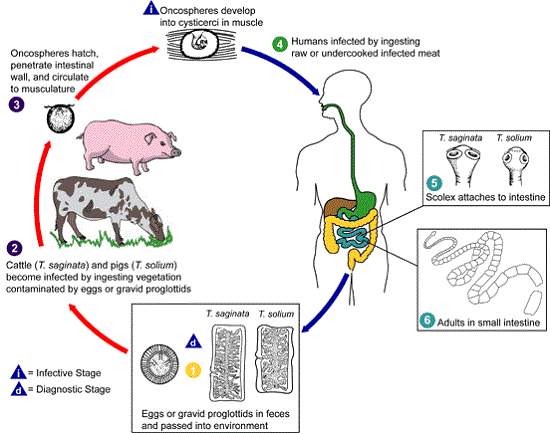Taenia saginata - Life Cycle, Pathogenesis, Pathology, Host Immunity, Clinical Manifestation, Complication, Prognosis, Epidemiology
Life Cycle of Taenia saginata
The life cycle of Taenia saginata is completed in two different hosts:
Intermediate hosts: Cattles (cow, buffalo) are intermediate hosts where larval development takes place
Definitive host: Man is the only definitive of Taenia saginata as they harbor the adult tapeworm. Man is the only naturally susceptible host.
Infection of Taenia saginata starts if humans consume raw or undercooked beef infested with Cysticercus bovis
the larvae are digested-free in the small intestine
once it comes in contact with the bile, the scolex evaginates to attach to the intestinal wall
after adhering to the host intestinal wall, it produces a chain of segments from the caudal end of the scolex and eventually develops into an adult tapeworm within 8 weeks to 12 weeks
eggs are fertilized within the sexually mature segments
as the Taenia saginata parasite matures, the terminal gravid proglottids separate individually from the end of the tapeworm and are expelled along with the feces
some segments can also crawl out of the anus onto the perianal skin and be dropped off in the stool mass
while some segments break partially to release eggs in the feces
when cattle eat grass during grazing, they may acquire the infection after ingesting intact gravid segments or the eggs
inside the cattle stomach, each gravid segments disintegrate to release 50,000 to 80,000 eggs
from each egg, a six-hooked embryo called an oncosphere emerges
Taenia saginata embryos are termed hexacanth embryos, adhere to the intestinal wall by their suckers and invade the mucosa and vessels of the submucosa
the parasites are eventually carried via the lymphatic or circulatory system to striated muscles
in the host muscles, within 60 days to 75 days, the Taenia saginata embryo develops into fluid-filled cysts called Cysticercus bovis
although Cysticercus bovis is mostly found in the skeletal muscles, it can also be found in the cardiac muscles, fats, visceral organs, and the tongue
the Cysticercus bovis can remain viable in the intermediate hosts for up to 8 months after which they die, disintegrate, and become fibrotic and calcified

Fig: T. saginata lifecycle (Source: CDC)
Pathogenesis, Pathology of Taenia saginata
Since the adult Taenia saginata is non-pathogenic, it rarely produces any damage to the intestinal mucosa.
Host Immunity of Taenia saginata
The adult tapeworm induces a weak host immune response. The immunogenic response may range from moderate eosinophilia and increased levels of serum IgE. As a result, the parasite may be able to survive in the host intestine for a longer period of time.
Clinical Manifestation of Taenia saginata
Taenia saginata is a large zoonotic tapeworm causing intestinal taeniasis in humans. The parasite does not cause cysticercosis and the infection is harmless and asymptomatic in most cases.
Intestinal taeniasis
is mostly asymptomatic
if symptoms are present, clinical syndromes are mild and non-specific
symptoms include- nausea, abdominal discomfort, unexplained weight loss, constant hunger, pain, indigestion
uncommon symptoms are fever, diarrhea, vomiting
nausea and abdominal discomfort are the most common in the mornings
if proglottids crawl out of the anus during the day, it may cause psychological distress

Image: adult T. saginata measuring 12 feet (Source: cych.org)
Complications of Taenia saginata
Rare complications include intestinal obstruction, pancreatitis, appendicitis, etc.
Prognosis of Taenia saginata
The prognosis of Taenia saginata infection is excellent with treatment with a success rate of around 99% to 100%.
Epidemiology of Taenia saginata
Taenia saginata infection is cosmopolitan in distribution.
It is most common in cattle-breeding regions or countries where hygiene is poor. Endemic regions include Central Africa, East Africa, South-central Asia, and Mediterranean countries (Syria, Lebanon, Bosnia, and Montenegro).
Reservoir, Source of Taenia saginata
Humans are the only reservoir of Taenia saginata infection. A single person can infect several hundreds of cows.
Contamination of the environment such as water sources and lands where animals graze is the source of infection for intermediate hosts.
Transmission of Taenia saginata
Transmission of Taenia saginata occurs by
consumption of raw or undercooked beef harboring cysticerci
tasting meat dishes during the cooking process